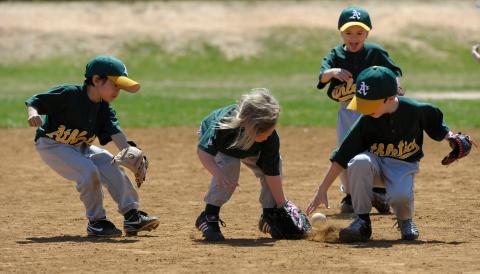Confessions of a Major League T-Ball Coach
The New York Times
May 8, 2015
by Doug Glanville
It was an honor, during the off-season, to have been interviewed for a job as a big-league manager of the Tampa Bay Rays. I wasn’t chosen to run their show, so I elected to develop my managerial chops another way. And while I won’t have the luxury of having the Rays’ star third baseman, Evan Longoria, in my lineup, who knows? I may have the future Evan Longoria.
I’m coaching my kids’ T-ball team.
It did not take me long to realize that T-ball is a tad different from the game I played during my major league career. It still involves a bat and a ball, a glove and a cap, maybe plastic cleats and some sliding, but outside of the uniform and tools of the trade, the similarity grinds to a screeching halt.
Our team dresses in burnt orange. The other day, we played a team that was purple. A ground ball was hit to the first-base side of the pitcher’s mound, and our entire team went after it. The mob stepped on everything in its path in an effort to get to first base, and eventually one player collected the ball. But his goal, whatever it might have been, was not to step on first or even tag the runner. The runner was irrelevant. The first baseman was irrelevant. And the poor child who hit the ball was swallowed up by a wave that made him look like a grape inside a swarm of honeybees. He had no chance of reaching the base through this dense fog of childhood persistence.
In the big leagues, this would have been clear obstruction and the umpire would have granted the runner his base (not to mention suspending at least five players for assault). In T-ball, it is legal; in fact, it builds camaraderie. My team was fired up, so I had to pat them on their collective back, but also explain that it does not matter who gets the ball, as long as you get the out.
I’m still not sure if the purple hitter was out, because once the ball was corralled (and I dare not guess the official position of the player who finally picked it up), the fielder decided to gently place it on top of the base, as if he were garnishing a plate of whipped cream with a marshmallow. He placed it with precision, and then let go, undistracted by the seven teammates who were still going after it. This resulted in a work of art, but as the man responsible for safety in this tornado, I had to think quickly about whether the runner would sprain his ankle stepping on the ball adorning first base — that is, if he ever got to first. Which, thanks to the Great Wall of Orange Marmalade, he could not manage to do.
These in-game moments made me think about what I would like to impart to young baseball players. There are a lot of rules in baseball, and rules and 6-year-olds don’t always go well together. But kids do respect rules that help them compete, know the score and, most important, make the game fun. I had to think about how to balance that equation, especially when safety comes first and foremost.
I do believe that I am slowly making progress in getting my players to hold their ground and cover their “spot.” I noticed that one was running from first base all the way across to left field on every ball hit to the outfield. Then I realized that it was my son, and it became clear that I wasn’t sure how deep this rabbit hole of amoebic positioning could go.
So I decided to have a team meeting to explain the idea of a “position.” To simplify, instead of “shortstop” or “right field,” I used terms like “that side of this line I am drawing in the dirt” or “stand in these two holes I just dug for you.” These kids are sharp, so by season’s end, I have no doubt they’ll be doing double relays with cutoff men and identifying positions reserved for expert fans and players, like “utility infielder.”
Generally, defense is a challenge because you have to manage all the players at one time. If I say nothing, we might default to the kind of wayward defensive tactics that begin to resemble offensive tactics. Tactics that only Civil War Commander William Tecumseh Sherman and his horrific “March to the Sea” approach could appreciate (then again, he later did declare that “War is Hell”).
Base running is a little more straightforward, even though it can create moments I have never seen or imagined before in my life. The other day, we had three runners on third at the same time. After first trying to sort it out, I thought, “No big deal, let me see what happens when the hitter puts the ball in play.” So he did, and two out of the three ran home. Not bad. (Since we don’t keep score, I didn’t have to explain to some stats department how someone knocked in two runs with both runners starting from third base.) I was never clear how I would have scored the runner who elected to stay — who essentially got lapped, since he was the first runner to get to third — but I will figure it out before our next game.
In fairness to this brand of baseball, the basic rules are different. No outs or runs are really recorded; everyone in the lineup hits; every hit is a single; and coaches pitch against their own team. Oh, and forget about the pace-of-game rules that major league baseball implemented this season to speed things up: our game the other night whipped through two innings in two hours. Somewhere, I heard Rob Manfred, the commissioner of Major League Baseball and the architect of “speed-up rules,” scream in horror.
I had been warned about the nuanced challenges of coaching your own children. Not a straightforward exercise. The day of our opening game was cold, and who was the player kneeling, mid-inning, in deep right field wearing rain boots and a jacket over his uniform, hands in his pocket and hatless? My son. This does not jibe with my rule to “always be in an athletic position” on defense. The scouting report on my son is as follows: Nice swing, good hustle, highly competitive, reads books with teammate’s sister between innings, intolerant of the cold or frivolous rules (all rules are frivolous).
My daughter, who is also on the team, has two primary concerns: When are we going to get a drink of water and when can she steal a base (the latter strikes me as purely hypothetical). But I like her thinking here. Scouting report: Great mechanics, fast learner, fast runner, needs to adjust the location of her swing to make more contact, always thirsty, literally.
At times, as we try to bring along our pure rookies, I do feel for the kids who were weaned on baseball and actually understand some of the game. Our shortstop/second base combo is like having the Red Sox’ Bogaerts and Pedroia. They are serious, they know the rules, they came dressed in full Red Sox regalia during our two-day “spring training.” So when a teammate “spiked” the ball on first base, thinking this was how to record an out, the Bogaerts half of my double play tandem was perplexed.
“This is his first game, he is learning,” I explained. He said, “O.K., no problem, I understand.”
I applauded his willingness to help others learn the game, and then I appointed him player-coach. He’s 6. I will pay him in sunflower seeds.
He will need those seeds to kill time. T-ball is subject to a range of delays that have nothing to do with rain. Nor do they come from pitching changes or from challenging a call with Instant Replay. No. Our catcher went off to the Port A Potty; another one of our players was shaken up after being engulfed by his own teammates (eight apparent shortstops trampled him to get a ball hit near the pitcher’s mound); a couple of other players found the joy in knocking each other’s hats off at second base — until they found themselves disoriented in the evil and boring outfield. (There is something mischievous about second base. Not sure what it is, but for some reason, players think they are invisible there. But I digress.)
In the end, my goals are not to win the American League East. They are to make sure these kids have fun, learn to love the game of baseball and respect the importance of team, and are safe. Guaranteeing safety with amped-up 5-to-7-year-olds wielding metal bats is a serious gig, requiring laserlike focus, a stentorian voice and a lot of help.
And even though, to a former big-leaguer, it looks different from the game I played for most of my life, I know this is the time when kids find joy and a passion in it. When I see the smiles on their faces — even when 10 of them are chasing a ball that was called foul an hour earlier and has long since come to rest — I realize they are truly having fun. I recognize how much they improve from game to game, and how quickly they learn and retain information.
Then I remember how I came to love baseball and thank them for maybe the greatest reminder of all: There is nothing more powerful than loving something without even having to understand it.
Republished from NYTimes.com
Photo Credit: Toni L. Sandys/The Washington Post, via Getty Images






